My
purpose in this review is to look at the ACE model’s BMP-1
and BMP-2 Infantry Fighting Vehicles (IFVs) and see how they are
similar and how they different from each other, to examine them
for accuracy, and to look at them as models and, as such, to the
quality of the molding.
Vehicle
History For The Modeler
The BMP-1 and the BMP-2 are Cold War era infantry transport and
support vehicles developed in the late 1960’s and early 1970s
respectively. The BMP-2 is kind of an upgraded BMP-1 based on evaluation
of experience of the Egyptian and Syrian Armies during the October
1973 War with Israel.
The BMP-1 is armed with a low velocity 73-mm main gun, machine gun,
and 9K11 Malyutka (NATO name AT-3 Sagger) AT missile; the BMP-2’s
larger turret is armed with a 30-mm autocannon and machine gun and
a 9M113 Konkurs (NATO name AT-5 Spandrel) guided missile.
The BMP-1 has a crew of three and room for eight infantry while
the BMP-2 has seating for one fewer infantry. Both are amphibious,
lightly armored and have two rear doors for the infantry to exit.
Their hulls are almost identical except for obvious external differences
of the side skirts. Furthermore the BMP-1 has four roof hatches
for the troops while the BMP-2 has only two, though larger, roof
hatches because of room taken up by the larger turret. There exists
a veritable plethora of variants, upgrades and modifications to
both the BMP-1 and BMP-2 IFVs.
A
Look at the Box Art, What is supposed to be inside.
The box art for the BMP-1 kit 72137 appears to be an actual photograph
of a BMP-1 or else an exceptionally good painting; using a photo
seems an interesting anomaly to me. We see the small round flat-topped
conical turret with the half-circle hatch open. There is no Sagger
missile mounted on the launcher visible in front of the open hatch
but the main gun is evident. To me this appears to be a standard,
initial-production BMP-1.
On the rear deck we see one of the four hatches open. On the rear
side of the hull we can make out four teardrop-shaped rifle ports
below the roof-mounted periscopes. On the rear we can make out the
two passenger doors that bulge out because the doors are designed
to also be fuel tanks. There are periscopes at the top of the doors
and a gun port in the left door.
The
IFV runs on of six rubber-tired roadwheels with torsion bar suspension,
a drive sprocket in the front and idler wheel in the rear, and all-steel
track. The vehicle in the photo appears to be front heavy, perhaps
due to no load of troops and ammunition in the rear?
The
vehicle color appears to be gray green with soft edged olive green
patches, but because of photography and the box printing these colors
may not be reliable.
With ACE’s BMP-2 Late Version box art we are back to a dynamic
painting of the vehicle that I am used to from ACE models. The vehicle
appears placed in Afghanistan during the 1980’s. I understand
that this BMP-2 variant is called “Late version” due
to the appliqué armor mounted on the turret. The vehicle
appears painted in a gray-green color with black patches.
Starting
from the turret we see the long 30-mm autocannon, several small
searchlights, and appliqué armor plates on the turret sides.
No Konkurs AT missile launcher is mounted atop the turret though
it is included in the kit.
On
the glacis is the large engine access hatch with horizontal slats
which I understand help deflect water while the vehicle is in the
water. The bow looks pretty much the same as the BMP-1. On the forward
quarter is a short tow cable running back to amidships. Except for
the side-skirt and the turret this looks very much like the BMP-1
from this angle.
The Kit Parts
The ACE BMP-1 kit 72137 consists of about 56 white injection-molded
styrene plastic vehicle parts, and 48 link & length track parts,
and 15 etched brass parts.
The ACE BMP-2 Late Version kit 72135 consists of 80 white, injection-molded
styrene plastic parts not including 48 link & length track parts
and about 19 etched brass parts. ACE has produced many variants
of their BMP models so the number of plastic and brass parts can
vary greatly depending on the kit.
Both kits are made from “short- or limited-run” molds
which are less expensive to produce than the molds used by the likes
of ESCI, Revell, Hasegawa, etc., though the short-run molds wear
out sooner leading to parts with flash and soft detail.
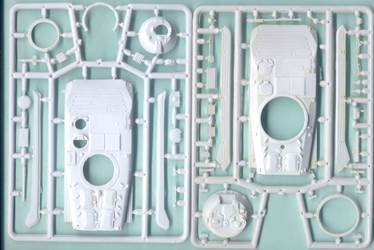
Above we have comparable sprues for the BMP-1 at left and the BMP-2
at right comparing upper hull parts and turret parts. The overall
shape of the hulls looks pretty much the same.
The
BMP-1 has a smaller turret ring, and the four roof hatches for the
infantry compartment. The driver and commander hatches are molded
open. At top are the top and bottom turret parts 38 & 31 with
an open gunner’s hatch. At upper left we see the Sagger AT
missile (a NATO designation for this missile). Detail looks good
though my sprue here has a lot of flash in places which I understand
indicates a worn mold.
The
BMP-2 hull on the right sprue displays the larger turret ring and
turret. Detail looks good with less flash than on my BMP-1 kit.
All the hull and turret parts are molded closed unfortunately. I
recommend small parts like the shovel (part 41) and tow cable (part
43) be carefully scored with a sharp blade to remove them from the
sprue rather than using clippers so they do not break. The 30-mm
gun for the BMP-2 is a little thick and I plan on replacing it with
some brass tube; oddly, this gun barrel part is labeled part 39
on the parts diagram, but part 47 on the assembly instructions.
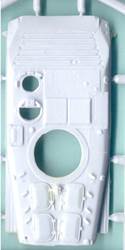 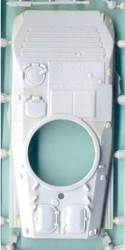
In a close-up of the two hulls we see that the open commander’s
hatch behind the driver is different from the comparable hatch on
the BMP-2. A reason for this is that in the BMP-2 the commander
is stationed in the turret and this hull position is occupied in
the BMP-2 by an infantryman. It is too bad that ACE molded the BMP-2
roof hatches closed.
The
BMP-2 hull looks well cast with sharp features. The glacis of my
BMP-1 upper hull looks deformed and irregular, probably due to a
worn mold.
A significant
issue with the BMP-2 are the infantry hatches on the rear deck which
here are the same hatches as on the BMP-1 kit, just two fewer of
them. My references show that the actual BMP-2 had different, larger,
roof hatches. For a historically accurate BMP-2 we’ll have
to cut these two hatches off and build new ones.
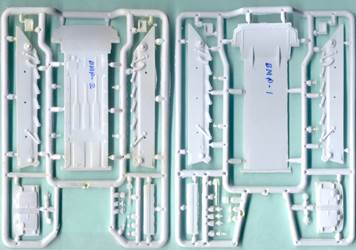
These sprues above showing the lower hull parts are essentially
the same and appear interchangeable between the BMP-1 and BMP-2
kits. It is interesting to me that ACE flipped some of the parts
around which is why we see the hull sides in the same orientation
but the rear doors flipped to the other side of the sprue and the
hull bottom turned over.
The
axles for the wheels are molded very short. On other ACE kits I
built, this lead to wobbly wheels. You may want to drill out the
axles and wheels and install longer axles made from brass tube or
plastic rod.
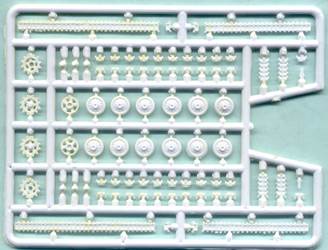
The sprue of plastic link & length tracks and wheels appear
identical for both model kits. The track detail looks good and I
personally prefer these over etched brass tracks included in some
ACE kits; they are not as nice as the soft band tracks included
in the newer ACE models, however. Some cleaning and shaping with
a small file is expected. These are “dead” track so
there will be some sag on the top run but which will be covered
by the side skirt.
The
wheels look well detailed and again may need sanding and clean-up
of flash. I recommend drilling out the mounting holes and installing
longer axles.
Assembly Instructions
Both ACE kits have exploded-view line drawing instructions in minimal
steps, typical of other ACE models. Instructions are adequate but
look a little busy to me so study them carefully and test fit before
you glue.
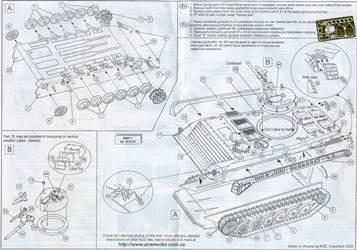
At upper right of the BMP-1 instructions is a small etched brass
fret containing the gun port covers, headlight guards, and rear
fender pieces to replace kit parts 10 and 22. Atop the turret (lower
left) there is a sight fixture assembled from etched brass pieces
and a clear window that we have to supply.
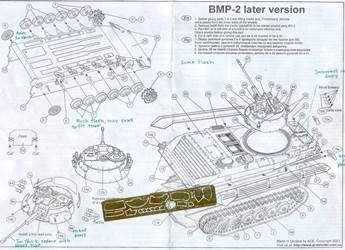
BMP-2 hull assembly looks pretty much the same as for the BMP-1
but with significant differences in the turret. The etched brass
fret is notably larger containing parts for the turret’s appliqué
armor. I commend ACE for supplying etched brass that are well rendered.
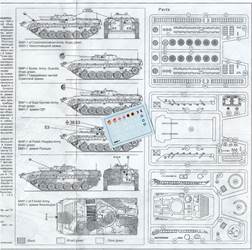
One of the best things about ACE kits are the colorful decals for
a variety of vehicles. With this BMP-1 we have a choice of Czech,
Soviet, East German, Polish and Finnish armies. At right is the
sprue diagram. There are no part numbers on the sprues so refer
to this diagram to identify the parts. Several unused parts have
been X’d out.
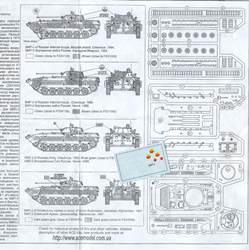
This ACE BMP-2 kit offers a similar parts diagram and assortment
of water-slide decal vehicle markings for Soviet vehicles serving
in Chechnya or Afghanistan. Camouflage patterns are only shown in
two views so we’ll have to use “artist’s license”
and common sense to finish the paint schemes.
Conclusion
Overall, despite some rough molding, I very much like these kits.
At this moment, the ACE BMP-1 and BMP-2 kits are out of production
but I predict and hope that ACE will start making them again, and
perhaps BMP-3 kits as well.
At
this time, ACE is the only manufacturer that has produced the BMP-1
and BMP-2 IFVs in plastic. Considering how many thousands of these
have been produced, and by a half dozen nations, I am surprised
no other plastic kit maker has produced them; I mean, do we really
need another Panzer IV or Tiger tank?????
ARMO
produces resin kits of both IFVs and there are aftermarket gun barrels,
wheels and etched brass frets available, e.g. from OKB
Grigorov.
|